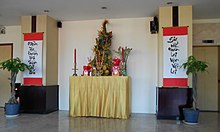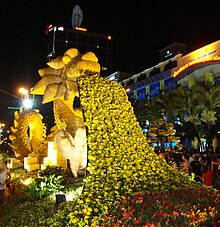Tết Nguyên Đán

Tết Nguyên Đán ( Hán Nôm : 節 元旦 , dt. "Festival of the First Morning"), Tết for short , is the most important Vietnamese holiday, the festival of the new year according to the lunar calendar . Tết is celebrated from the first day of the first month of the Chinese lunar calendar to the third day, according to the European calendar roughly in the zodiac sign Aquarius (between January 21st and February 21st). Vietnamese visit their families and the temples on Tết, and their own festive dishes are prepared. Tết also marks the beginning of spring.
Schedule
Tết is divided into three periods: Tất Niên (the preparation for the festival), Giao Thừa (the eve of the festival) and Tân Niên (the festival days).
Tất Niên
The preparations for the festival begin months before the actual festival. People are paying back their debts to start the new year debt free. Parents buy their children new clothes and supplies are created. In the days leading up to Tết, the markets and shops are full of people buying food and drink, clothing, and the New Year's decorations for the home. Vietnamese who are separated from their families, if possible, go home to celebrate the festival with their families.
Giao Thừa
On the eve of the festival, the apartments and houses are carefully cleaned and decorated with flowers or gifts for the ancestors. Many families set off fireworks at midnight, although this has been officially banned since 1995 for safety reasons. The next morning, the actual celebrations for the Tt begin.
Tân Niên
The first day of the New Year celebrations, which lasts several days, is spent with the family, the streets in big cities are mostly deserted. Children have put on new clothes and greet the elderly with a New Year's greeting. Then they will receive a decorated red envelope with money. Since the Vietnamese assume that the first visitor in the New Year determines family happiness in the coming year, you never enter a strange house on the first day without an explicit invitation. People are invited who were lucky in the past year or who are considered lucky charms for other reasons. The first outside person entering a household at Tết is called xông đất or đạp đất . Another important custom is that on the 1st day (the ngày mồng Một) you are not allowed to dispose of the garbage or sweep the house, otherwise you will remove happiness from the house.
On the following days, the Vietnamese visit relatives, friends and local Buddhist temples to donate money or to be prophesied of the future. The children are allowed to spend their money on games. There are public dance performances, wealthy Vietnamese invite a dance group into their own house.
Customs and traditions
There are a multitude of customs and traditions at the largest festival, ranging from decorating your own home to dishes that are traditionally served on New Year's Day.
decoration
The New Year tree cây nêu is an obligatory part of the decoration. It consists of a bamboo tube up to five or six meters long , the top of which is adorned with various objects such as origami in the shape of a fish or cactus branches. Dwarf orange trees are often used to decorate the living room . The fruits symbolize the family's wish for a fruitful New Year.
food and drinks
Meals are an important part of the Tết festival and are often prepared for days. These include in particular:
- bánh chưng and bánh dầy : Traditional cake consisting of large leaves filled with sticky rice , beans or meat (lá dong). The cakes are rectangular and are called bánh chưng (symbol for the earth) or round bánh tét (symbol for the sky). They are part of every Tết celebration.
- hạt dưa : Roasted watermelon seeds .
- củ kiệu : onion hearts marinated in brine.
- mứt or mứt dừa : Dried and candied coconut meat .
In South Vietnam fruits are presented as on the family altar Annona reticulata ( Mang cầu ), coconut ( DUA ), papaya ( dju dju ) and Mango ( xoài ) because they sound in the South Vietnamese dialect as components of the sentence "cầu BOI dju Xai" ( German: [We] pray for enough [money] to spend).
Greetings
The traditional greetings, which correspond to the German "Happy New Year", are "Chúc mừng năm mới" and "Cung chúc tân xuân" . The Vietnamese wish each other prosperity and happiness. Common greetings for the Tết are:
- Sống lâu trăm tuổi (You should live a hundred years): With this, children greet older relatives and friends.
- An khang thịnh vượng (Security, Health and Wealth)
- Vạn sự như ý (A myriad of things you wish for)
- Sức khoẻ dồi dào (Best Health)
- Tiền vô như nước (The money should flow in like water)
Tết Nguyên Đán
Tết Nguyên Đán is also celebrated in China.
Date (2000-2025)
| Date of New Years Day | designation |
|---|---|
| February 5, 2000 | Year of the Metal Dragon (Thìn, Rồng ) |
| January 24, 2001 | Year of the Metal Snake (Tị, Rắn ) |
| February 12, 2002 | Year of the Water Horse (Ngọ, Ngựa ) |
| February 1, 2003 | Year of the Water Goat (Mùi, Dê ) |
| January 22, 2004 | Year of the Wood Monkey (Thân, Khỉ ) |
| February 9, 2005 | Year of the Wood Rooster (Dậu, Gà ) |
| January 29, 2006 | Year of the Fire Dog (Tuất, Chó ) |
| February 17, 2007 | Year of the Fire Pig (Hợi, Lợn ) |
| February 7, 2008 | Year of the Earth Rat (Tí, Chuột ) |
| January 26, 2009 | Year of the Earth-Water Buffalo (Sửu Trâu ) |
| February 14, 2010 | Year of the Metal Tiger (Dần, Hổ ) |
| February 3, 2011 | Year of the Metal Cat (Mão Mèo ) |
| January 23, 2012 | Year of the Water Dragon (Thìn, Rồng ) |
| February 10, 2013 | Year of the Water Snake (Tị, Rắn ) |
| January 31, 2014 | Year of the Wood Horse (Ngọ, Ngựa ) |
| 19th February 2015 | Year of the Wood Goat (Mùi, Dê ) |
| February 8, 2016 | Year of the Fire Monkey (Thân Khỉ ) |
| January 28, 2017 | Year of the Fire Rooster (Dậu, Gà ) |
| February 16, 2018 | Year of the Earth Dog (Tuất, Chó ) |
| 5th February 2019 | Year of the Earth Pig (Hợi, Lợn ) |
| January 25, 2020 | Year of the Metal Rat (Tí, Chuột ) |
| February 12, 2021 | Year of the Metal Water Buffalo (Sửu Trâu ) |
| February 1, 2022 | Year of the Water Tiger (Dần, Hổ ) |
| January 22, 2023 | Year of the Water Cat (Mão Mèo ) |
| February 10, 2024 | Year of the Wood Dragon (Thìn, Rồng ) |
| January 29, 2025 | Year of the Wood Snake (Tị, Rắn ) |
Time differences
Since China and Vietnam are in different time zones, the calculation of the calendar year is also different. Between the years 2000 and 2100, the Chinese and Vietnamese New Year celebrations fall three times on different days.
| Time differences in the New Year | |||
|---|---|---|---|
| year | Vietnamese New Year | Chinese New Year | |
| 2007 | February 17th | February 18 | |
| 2030 | February 2nd | 3 February | |
| 2053 | February 18 | 19th of February | |
See also
Web links
Individual evidence
- ↑ a b New Year's Flowers. Retrieved February 7, 2016 .


